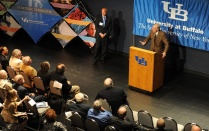UBNow features Heather Williams and REU success

UB News columnist Charlotte Hsu presents an interview with Heather Williams about the success of the department’s Research Experiences for Undergraduates (REU). From June to July, UB biologists hosted seven undergraduates from various institutions working in labs focused on a broad range of topics within biology. The eight-week program, funded by proceeds from the National Center for Case Study Teaching in Science, covers students’ travel and living expenses, and also includes a stipend for participants. Undergraduate students are invited to apply for REU Summer 2023.
Understanding the Rules of Life
Q&A
Biologists launch summer research program for undergraduates

Undergraduate researcher Sophia Jacobs works in the lab of Omer Gokcumen, associate professor of biological sciences. Photo: Courtesy of the Department of Biological Sciences
By CHARLOTTE HSU
Published October 3, 2022

Heather Williams
The Department of Biological Sciences has launched a Research Experiences for Undergraduates (REU) program, joining units across the university that offer opportunities for students from other institutions to spend several weeks at UB conducting research each year.
The initiative, funded by proceeds from the National Center for Case Study Teaching in Science, began this summer. From June to July, UB biologists hosted seven undergraduates from California, Florida, Georgia, New Jersey, Puerto Rico and Texas. The students worked in labs focused on a broad range of topics within biology.
And the department is already getting ready for the next year: Applications have opened for the 2023 summer REU, with an initial application deadline of Jan. 31, 2023. The eight-week program covers students’ travel and living expenses, and also includes a stipend for participants.
Heather Williams, assistant clinical professor in biological sciences and director of the department’s REU, took time to speak with UBNow about the program’s successful first summer.
Why did the department decide to launch an REU program?
We are doing great research and have some great facilities here in our department. We wanted to be able to share that with a wider audience. As part of our recruitment, we advertised to undergraduate students at institutions which do not have as many research opportunities as our students here at UB enjoy. We also advertised the program to colleges that have a high percentage of students from underrepresented groups. That is important to us as a department, as we hope to continue to recruit a diverse population of graduate students. We hope that by investing time and funds in some really promising undergraduate students from around the country, we might tempt them to consider UB as a great place to come to graduate school.
What were some highlights of this summer's REU program?
My favorite day was seeing the students present their research in a poster symposium at the end of the program. It was great to see how much they had accomplished in their research and how confident they were in presenting it to others. The students also made the most of their time here in Buffalo and enjoyed trips out to Niagara Falls, Devil’s Hole State Park, volunteered for a day at Reinstein Woods and tried out kayaking around the Tonawanda Canal Fest.
How do student participants benefit from the REU experience?
All of the students in the program were selected because they are interested in a career in scientific research. The program gives them an immersive experience of what that is like in practice by providing them with experience as junior researchers in our labs, under the guidance of our research faculty. The students get a chance to really develop their lab skills and their research skills, while at the same time getting a real perspective on the lifestyle of a scientific researcher. Students also get the chance to make a lot of connections with our faculty and graduate students. One of the most popular aspects with the participants was definitely some of the networking opportunities they took part in as part of field trips around Western New York. We also include a range of professional development activities in the program, so students attend workshops on topics such as scientific writing and applying to graduate school.
How has the REU program been rewarding for faculty and students within the biological sciences department?
I personally found it inspiring to see how far the students came in their eight weeks with us. By the end, they were comfortably throwing out technical terms from their disciplines and routinely performing pretty complex lab procedures. To see that level of change in such a short time was hugely impressive.
